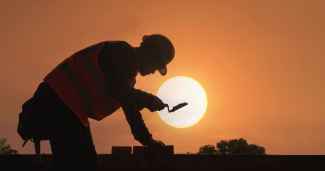Supervisor Believed Construction Worker Was on Drugs. He Was Dying of Heat Stress.

[Editor’s Note: The unprecedented heat across the country continues. As the climate crisis worsens, the health risks of heat for outdoor workers intensifies. This is the second post in a series on the impact of heat on the communities we serve. Read the first installment, “It’s Hot, But Do Workers Have to Die?”]
This week, the mother of Gabriel Infante sued his employer for $1 million, one year after the 24-year-old died of heat stress on the job. Infante’s supervisor believed he was on drugs – when in fact he was suffering from heat stroke, and died later that day.
When heat stress advances to life-threatening heat stroke, the body’s core temperature rises above 106 degrees. Infante’s temperature was above 109 degrees. In an effort to cool the body, blood is directed to the skin, which reduces oxygen in the body and blood flow, increasing inflammation throughout the body and straining multiple organs. Simultaneously, heavy sweating depletes the body’s fluids, further straining the kidneys. Together, these body changes can rapidly lead to heart failure, kidney failure, gut lining disintegration, and blood poisoning. During heat stroke, organs are swelling and beginning to fail; those who manage to recover from heat stroke will likely still have permanently damaged organs. Those experiencing heat stroke will experience altered mental states and confusion, seizures, dizziness, and loss of consciousness.
“Death from heat is preventable. No one, and certainly no worker, should ever die from the heat," said Amy Liebman, Chief Program Officer of Workers, Environment, and Climate for Migrant Clinicians Network. Yet, few people in workplaces have any training on heat stress, to ensure workers don’t advance to dangerous heat stroke and die. There aren’t any federal rules in place to mandate that outdoor workers in the heat can access cool water and shade, and provided with time to rest. Just a small handful of states – California, Washington, Oregon, and Colorado– have heat standards for outdoor workers in effect, with a few others currently in the process of issuing heat regulations. Yet, a piecemeal approach inevitably leaves workers behind, in those states that do not adopt a policy. If a high-quality federal heat standard had been in place during Infante’s deadly week of work, what could have changed?
Water, rest, and shade: Infante did not get a chance to take a break for his body to recover. Under Oregon’s heat standard, employers must provide access to shade and water when it’s 80 degrees or above, and when the heat index is 90 degrees or above, employers must communicate closely with supervisors, monitor employees, and provide employees with a rest period of 10 minutes for every two hours of work. “Water, rest, shade” is the mantra of heat stress advocates and is the cornerstone of any good heat standard. Infante seemingly did not have access to any of them.
Acclimatization: Infante had just begun his job digging up streets for the placement of fiber optic cable – meaning, he was likely not acclimated to the heat, which that day was around 100 degrees, with 75% humidity. California’s heat standard requires employers to closely observe employees who are newly assigned to a high heat area for the first 14 days. A federal standard should limit the hours of the newly employed, mandate regular breaks with water and shade, and require employers to not just check in with employees but to step in and enforce rest, water, and shade if the employee is experiencing early signs of heat stress.
Training, for supervisors and employees: Infante was likely unaware of the seriousness of heat stress, until it was too late. His supervisor was clearly lacking training on heat stress, believing Infante was using drugs, rather than recognizing hallucination as a symptom of heat stroke. In Washington state, employers are required to create written outdoor heat exposure safety programs in a language the employees understand, and provide annual trainings to teach employees – including supervisors – the signs and symptoms of heat-related illness, as well as the policies in place to prevent it. A federal standard should similarly require annual trainings and workplace postings, both provided at the appropriate literacy level and in the languages of the employees. These trainings would include not just signs and symptoms, and ways to avoid heat stress, but the avenues that workers can take should their employers not provide a safe workplace during heat episodes.
“A well-implemented heat standard in his state or, ideally, across the entire country could have prevented Infante’s death – and many others that have happened just in the last few weeks,” Liebman said. “As we’ve seen this summer, the climate crisis is here, creating deadly conditions in many workplaces. There’s no time to delay – a federal heat standard is needed now, to stop these fully preventable deaths.”
- Log in to post comments
